 W
WAn optical fiber is a flexible, transparent fiber made by drawing glass (silica) or plastic to a diameter slightly thicker than that of a human hair. Optical fibers are used most often as a means to transmit light between the two ends of the fiber and find wide usage in fiber-optic communications, where they permit transmission over longer distances and at higher bandwidths than electrical cables. Fibers are used instead of metal wires because signals travel along them with less loss; in addition, fibers are immune to electromagnetic interference, a problem from which metal wires suffer. Fibers are also used for illumination and imaging, and are often wrapped in bundles so they may be used to carry light into, or images out of confined spaces, as in the case of a fiberscope. Specially designed fibers are also used for a variety of other applications, some of them being fiber optic sensors and fiber lasers.
 W
WAn addressed fiber Bragg structure (AFBS) is a fiber Bragg grating, the optical frequency response of which includes two narrowband components with the frequency spacing between them being in the radio frequency (RF) range. The frequency spacing is unique for every AFBS in the interrogation circuit and does not change when the AFBS is subjected to strain or temperature variation. An addressed fiber Bragg structure can perform triple function in fiber-optic sensor systems: a sensor, a shaper of double-frequency probing radiation, and a multiplexor. The key feature of AFBS is that it enables the definition of its central wavelength without scanning its spectral response, as opposed to conventional fiber Bragg gratings (FBG), which are probed using optoelectronic interrogators. An interrogation circuit of AFBS is significantly simplified in comparison with conventional interrogators and consists of a broadband optical source, an optical filter with a predefined linear inclined frequency response, and a photodetector. The AFBS interrogation principle intrinsically allows to include several AFBSs with the same central wavelength and different address frequencies into a single measurement system.
 W
WAn optical attenuator, or fiber optic attenuator, is a device used to reduce the power level of an optical signal, either in free space or in an optical fiber. The basic types of optical attenuators are fixed, step-wise variable, and continuously variable.
 W
WBend radius, which is measured to the inside curvature, is the minimum radius one can bend a pipe, tube, sheet, cable or hose without kinking it, damaging it, or shortening its life. The smaller the bend radius, the greater is the material flexibility. The diagram to the right illustrates a cable with a seven-centimeter bend radius.
 W
WA fiber-optic cable, also known as an optical-fiber cable, is an assembly similar to an electrical cable, but containing one or more optical fibers that are used to carry light. The optical fiber elements are typically individually coated with plastic layers and contained in a protective tube suitable for the environment where the cable is used. Different types of cable are used for different applications, for example, long distance telecommunication, or providing a high-speed data connection between different parts of a building.
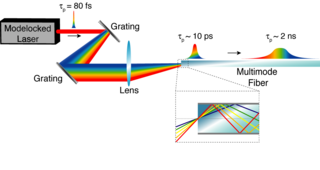 W
WChromo-modal dispersion (CMD) results from exciting various modes of a multimode waveguide with unique spectral components of a broadband optical signal. Modal dispersion during propagation in the waveguide then provides group velocity dispersion to the signal. The large modal dispersion inherent to multimode waveguides enables the dispersion per unit length of a chromo-modal dispersion device to be several orders of magnitude higher than that of diffraction grating or dispersion compensating fiber-based dispersive elements.
 W
WThe core of a conventional optical fiber is a cylinder of glass or plastic that runs along the fiber's length. The core is surrounded by a medium with a lower index of refraction, typically a cladding of a different glass, or plastic. Light travelling in the core reflects from the core-cladding boundary due to total internal reflection, as long as the angle between the light and the boundary is greater than the critical angle. As a result, the fiber transmits all rays that enter the fiber with a sufficiently small angle to the fiber's axis. The limiting angle is called the acceptance angle, and the rays that are confined by the core/cladding boundary are called guided rays.
 W
WA distributed Bragg reflector (DBR) is a reflector used in waveguides, such as optical fibers. It is a structure formed from multiple layers of alternating materials with varying refractive index, or by periodic variation of some characteristic of a dielectric waveguide, resulting in periodic variation in the effective refractive index in the guide. Each layer boundary causes a partial reflection of an optical wave. For waves whose vacuum wavelength is close to four times the optical thickness of the layers, the many reflections combine with constructive interference, and the layers act as a high-quality reflector. The range of wavelengths that are reflected is called the photonic stopband. Within this range of wavelengths, light is "forbidden" to propagate in the structure.
 W
WBreakout-style fiberoptic cable, is an optical fiber cable containing several jacketed simplex optical fibers packaged together inside an outer jacket. This differs from distribution-style cable, in which tight-buffered fibers are bundled together, with only the outer cable jacket of the cable protecting them. The design of breakout-style cable adds strength for ruggedized drops, however the cable is larger and more expensive than distribution-style cable. Breakout cable is suitable for short riser and plenum applications and also for use in conduits, where a very simple cable run is planned to avoid the use of any splicebox or spliced fiber pigtails.
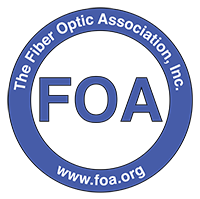 W
WThe Fiber Optic Association (FOA) is an international professional society of fiber optics. The FOA was founded in 1995 by a group of trainers from industry, government and education who wanted to create industry standards for training and certifying fiber optic technicians. The FOA is a not-for-profit 501(c)6 organization based in California, USA, that has over 200 affiliated training organizations in over 40 countries. FOA approves fiber optic training organizations and certifies their instructors who train designers, installers and operators of all types of fiber optic networks. FOA programs are used by many organizations, companies and trade unions to train and certify their workers.
 W
WFiber tapping uses a network tap method that extracts signal from an optical fiber without breaking the connection. Tapping of optical fiber allows diverting some of the signal being transmitted in the core of the fiber into another fiber or a detector. Fiber to the home (FTTH) systems use beam splitters to allow many users to share one backbone fiber connecting to a central office, cutting the cost of each connection to the home. Test equipment can simply put a bend in the fiber and extract sufficient light to identify a fiber or determine if a signal is present.
 W
WA fiberscope is a flexible optical fiber bundle with an eyepiece on one end and a lens on the other that is used to examine and inspect small, difficult-to-reach places such as the insides of machines, locks, and the human body.
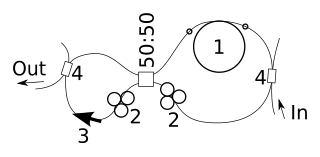 W
WA figure-8 laser is a fiber laser with a figure-8-shaped ring resonator. It is used for making pico- and femtosecond soliton pulses. The typical spectrum of such a laser consists of a wide central peak and a few narrow lateral peaks that are placed symmetrically around it. The amplitudes of the narrow peaks are the same as or less than that of the central peak.
 W
WFusion splicing is the act of joining two optical fibers end-to-end. The goal is to fuse the two fibers together in such a way that light passing through the fibers is not scattered or reflected back by the splice, and so that the splice and the region surrounding it are almost as strong as the intact fiber. The source of heat used to melt and fuse together the two glass fibers being spliced is usually an electric arc, but can also be a laser, a gas flame, or a tungsten filament through which current is passed.
 W
WGap loss is a type of signal strength loss that occurs in fiber optic transmission when the signal is transferred from one section of fiber or cable to another.
 W
WGradient-index (GRIN) optics is the branch of optics covering optical effects produced by a gradient of the refractive index of a material. Such gradual variation can be used to produce lenses with flat surfaces, or lenses that do not have the aberrations typical of traditional spherical lenses. Gradient-index lenses may have a refraction gradient that is spherical, axial, or radial.
 W
WA fibre-optic gyroscope (FOG) senses changes in orientation using the Sagnac effect, thus performing the function of a mechanical gyroscope. However its principle of operation is instead based on the interference of light which has passed through a coil of optical fibre, which can be as long as 5 kilometres (3 mi).
 W
WSophie LaRochelle is a Canada Research Chair and professor of engineering at the Université Laval. She specializes in developing fiber optic components for signal-processing and data transmission in telecommunication networks.
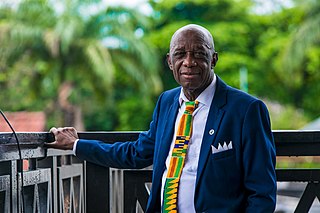 W
WThomas O. Mensah is a Ghanaian-American chemical engineer and inventor, who contributed to the development of fiber optics and nanotechnology. He has 14 patents, and was inducted into the US National Academy of Inventors in 2015. In 2017, Dr. Mensah served as Editor-in-Chief of the textbook Nanotechnology Commercialization, published by John Wiley & Sons.
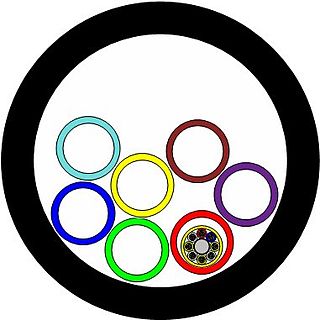 W
WMicroducts are small ducts for the installation of small microduct fibre optic cables. They have a size ranging from typically 3 to 16 mm and are installed as bundles in larger ducts.
 W
WIn optics, the numerical aperture (NA) of an optical system is a dimensionless number that characterizes the range of angles over which the system can accept or emit light. By incorporating index of refraction in its definition, NA has the property that it is constant for a beam as it goes from one material to another, provided there is no refractive power at the interface. The exact definition of the term varies slightly between different areas of optics. Numerical aperture is commonly used in microscopy to describe the acceptance cone of an objective, and in fiber optics, in which it describes the range of angles within which light that is incident on the fiber will be transmitted along it.
 W
WAn optical interleaver is a 3-port passive fiber-optic device that is used to combine (Mux) two sets of dense wavelength-division multiplexing (DWDM) channels into a composite signal stream in an interleaving way. For example, optical interleaver takes two multiplexed signals with 100 GHz spacing and interleaves them, creating a denser DWDM signal with channels spaced 50 GHz apart. The process can be repeated, creating even denser composite signals with 25 GHz or 12.5 GHz spacing.
 W
WAn optical time-domain reflectometer (OTDR) is an optoelectronic instrument used to characterize an optical fiber. An OTDR is the optical equivalent of an electronic time domain reflectometer. It injects a series of optical pulses into the fiber under test and extracts, from the same end of the fiber, light that is scattered or reflected back from points along the fiber. The scattered or reflected light that is gathered back is used to characterize the optical fiber. This is equivalent to the way that an electronic time-domain meter measures reflections caused by changes in the impedance of the cable under test. The strength of the return pulses is measured and integrated as a function of time, and plotted as a function of length of the fiber.
 W
WAn optical train, also called an optical assembly, is an arrangement of optical components to guide a line of sight and/or a laser beam. For example, the position and angle of lenses may be adjusted to guide a laser through the path required. Instruments like microscopes, telescopes and DSLRs all have optical trains that guide the incoming light towards a detector or the eye of an observer.
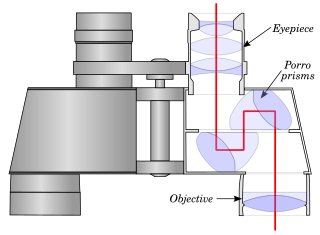 W
WOptomechanics can refer to:the sub-field of physics involving the study of the interaction of electromagnetic radiation (photons) with mechanical systems via radiation pressure or the manufacture and maintenance of optical parts and devices.
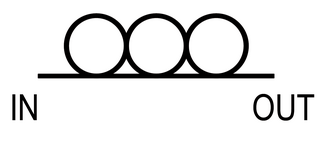 W
WA polarization controller is an optical device which allows one to modify the polarization state of light.
 W
WIn the field of antenna design the term radiation pattern refers to the directional (angular) dependence of the strength of the radio waves from the antenna or other source.
 W
WA splice box is a housing in which fiber optic cables begin or end. Fiber optics are fanned out in splice boxes that are situated at the end of fiber optic transmission paths.
 W
WStripping is the act of removing the protective polymer coating around optical fiber in preparation for fusion splicing. The splicing process begins by preparing both fiber ends for fusion, which requires that all protective coating is removed or stripped from the ends of each fiber. Fiber optical stripping can be done using a special stripping and preparation unit that uses hot sulphuric acid or a controlled flow of hot air to remove the coating. There are also mechanical tools used for stripping fiber which are similar to copper wire strippers. Fiber optical stripping and preparation equipment used in fusion splicing is commercially available through a small number of specialized companies, which usually also design machines used for fiber optical recoating.